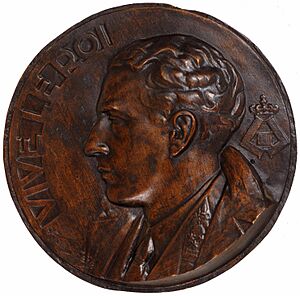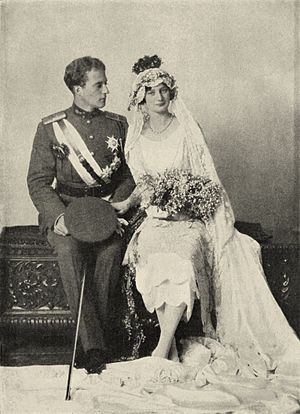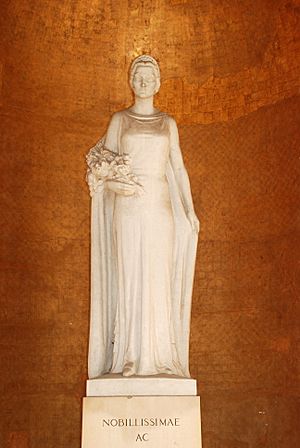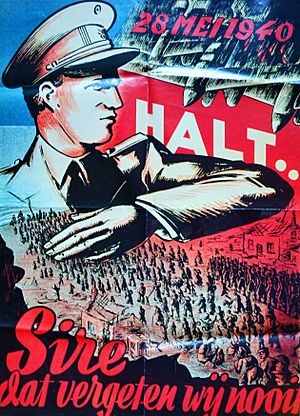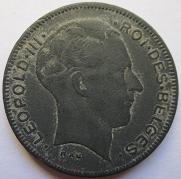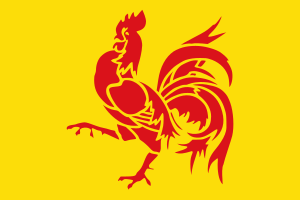Leopold III of Belgium facts for kids
Quick facts for kids Leopold III |
|||||
|---|---|---|---|---|---|
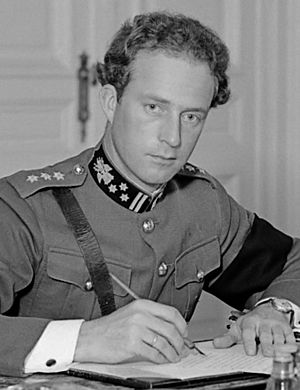
King Leopold in 1934
|
|||||
| King of the Belgians | |||||
| Reign | 23 February 1934 – 16 July 1951 | ||||
| Predecessor | Albert I | ||||
| Successor | Baudouin | ||||
| Regent | Prince Charles (1944–1950) Prince Baudouin (1950–1951) |
||||
| Prime Ministers |
See list
Charles de Broqueville
Georges Theunis Paul van Zeeland Paul-Émile Janson Paul-Henri Spaak Hubert Pierlot Achille Van Acker Camille Huysmans Gaston Eyskens Jean Duvieusart Joseph Pholien |
||||
| Born | 3 November 1901 Brussels, Belgium |
||||
| Died | 25 September 1983 (aged 81) Woluwe-Saint-Lambert, Brussels, Belgium |
||||
| Burial | Church of Our Lady of Laeken | ||||
| Spouse |
Astrid of Sweden
(m. 1926; died 1935)Mary Lilian Baels
(m. 1941) |
||||
| Issue |
|
||||
|
|||||
| House | Saxe-Coburg and Gotha (until 1920) Belgium (from 1920) |
||||
| Father | Albert I of Belgium | ||||
| Mother | Elisabeth in Bavaria | ||||
| Religion | Roman Catholicism | ||||
| Signature | |||||
Leopold III (born 3 November 1901 – died 25 September 1983) was the King of the Belgians. He ruled from 23 February 1934 until he gave up his throne on 16 July 1951.
When World War II began, Leopold wanted Belgium to stay neutral. But after Germany invaded in May 1940, he surrendered his country. This decision caused a lot of anger both in Belgium and other countries.
Belgium's Prime Minister, Hubert Pierlot, and his government said Leopold's surrender was against the country's laws. They moved to London to continue fighting as a government-in-exile. Leopold and his family were kept under house arrest. In 1944, they were moved to Germany and then Austria. American soldiers freed them, but Leopold was not allowed to return to Belgium for some years. His brother, Prince Charles, Count of Flanders, became regent (a temporary ruler).
Leopold finally returned to Belgium in 1950. This almost caused a civil war. Under pressure from the government, he gave up his throne to his son, Baudouin, in July 1951.
Leopold's first wife, Astrid of Sweden, died in a car accident in Switzerland in August 1935. People were very sad about her death. His second marriage to Lilian Baels in 1941 was controversial. It was done in secret and against Belgian law, which says a civil marriage must happen before a religious one. She was never called queen.
Contents
Early Life and Family Background
Prince Leopold was born in Brussels. He was the first child of Prince Albert, who was next in line to the Belgian throne, and his wife, Duchess Elisabeth in Bavaria. In 1909, his father became King Albert I, and Leopold became the Duke of Brabant.
In August 1914, when Germany invaded Belgium, Leopold was only twelve. His father, King Albert, allowed him to join the Belgian army as a private soldier. He fought to defend his country. However, in 1915, most of Belgium was occupied by the Germans. Leopold was then sent to Eton College in England, while his father continued to fight in France.
After World War I, in 1919, Leopold visited the Old Mission and Saint Anthony Seminary in Santa Barbara, California.
Leopold's Marriages and Children
Leopold married Princess Astrid of Sweden in a civil ceremony in Stockholm on 4 November 1926. A religious ceremony followed in Brussels on 10 November. They had three children:
- Princess Joséphine-Charlotte of Belgium, born on 11 October 1927. She became the Grand Duchess of Luxembourg.
- Prince Baudouin of Belgium, born on 7 September 1930. He became the fifth King of the Belgians.
- Prince Albert of Belgium, born on 6 June 1934. He became the sixth King of the Belgians. He gave up his throne in July 2013.
On 29 August 1935, a tragic accident happened. The King and Queen were driving in Switzerland near Lake Lucerne. Leopold lost control of the car, and it crashed into the lake. Queen Astrid died in the accident.
Leopold married Lilian Baels on 11 September 1941 in a secret religious ceremony. This marriage was not valid under Belgian law at first. Belgian law requires a civil marriage to happen before a religious one. The civil ceremony took place on 6 December 1941. They had three children:
- Prince Alexandre of Belgium, born on 18 July 1942.
- Princess Marie-Christine, born on 6 February 1951.
- Princess Marie-Esméralda of Belgium, born on 30 September 1956.
Belgium and World War II
When World War II started in September 1939, France and Britain wanted Belgium to join them. Leopold and his government refused. They wanted Belgium to stay neutral. Belgium had prepared well against a possible German invasion. They had built defenses to stop an attack like the one in 1914.
On 10 May 1940, the German army invaded Belgium. The main Belgian fort, Fort Eben-Emael, was quickly taken. German paratroopers surprised the defenders. Belgium was soon overwhelmed by the larger and better-prepared German forces.
However, the Belgian army's resistance helped the British and French troops. It prevented them from being trapped and cut off from the coast. This allowed for the famous Dunkirk evacuation.
After the military surrender, Leopold stayed in Brussels to surrender to the Germans. Meanwhile, his entire government fled to Paris and later to London.
The King's Surrender and Political Crisis
On 24 May 1940, Leopold, who was leading the Belgian Army, met with his ministers for the last time. The ministers wanted the king to leave the country with them. Prime Minister Hubert Pierlot reminded him that only the government could decide to surrender, not the king alone. Leopold said he would stay in Belgium with his soldiers, no matter what happened. The ministers thought this meant he might work with Hitler.
Leopold felt he would look like a deserter if he left. He said, "Whatever happens, I have to share the same fate as my troops." Leopold had often disagreed with his ministers. He tried to act on his own and limit their power.
French, British, and Belgian troops were surrounded by Germans at Dunkirk. Leopold told King George VI on 25 May 1940 that Belgian forces were being crushed. Two days later, on 27 May 1940, Leopold surrendered the Belgian army to the Germans.
Prime Minister Pierlot spoke on French radio. He said the king's surrender went against the Belgian Constitution. He explained that it was a political decision, not just military. The king acted without his ministers' advice, which was against the Constitution.
It was impossible to gather the Belgian Parliament at that time. So, after Belgium was freed in September 1944, the government asked Leopold's brother, Prince Charles, to be regent.
After Leopold's surrender, the British press called him names like "Traitor King." French Prime Minister Paul Reynaud also accused Leopold of treason. Some historians say Leopold was made a scapegoat.
Even Winston Churchill criticized Leopold's surrender. However, Belgian historian Francis Balace wrote that surrender was unavoidable. The Belgian Army could not fight the German army any longer. Churchill himself admitted the situation was dangerous for the Allies.
Life After the Fall of France
After Leopold surrendered, the Belgian government ministers went into exile. Most went to France. When France also fell to Germany in June 1940, some ministers tried to return to Belgium.
Because the king was very popular, and the government was not, the political crisis continued. On 2 August 1940, some ministers met in France. Prime Minister Pierlot and Foreign Minister Spaak decided to go to London. They traveled through neutral Spain and Portugal. They were arrested in Spain by Francisco Franco's regime. They finally reached London on 22 October.
Meeting with Adolf Hitler
Leopold refused to work with the government of Nazi Germany. He would not rule Belgium as the Germans wanted. So, the Germans set up a military government. Leopold tried to act as the head of the Belgian government, even though he was a prisoner. But the Belgian government-in-exile in London said the king did not represent Belgium.
The Germans held Leopold under house arrest at the Royal Castle of Laeken. Leopold wanted to meet Adolf Hitler to discuss Belgian prisoners of war. He finally met Hitler on 19 November 1940. Leopold wanted Hitler to release Belgian POWs and promise Belgium's future independence. Hitler refused to make any public statements about Belgium's independence. By not doing so, Hitler prevented Leopold from being seen as working with Germany. This saved Leopold from being accused of treason later.
Leopold's Second Marriage
On 11 September 1941, while still a prisoner, Leopold secretly married Lilian Baels in a religious ceremony. This marriage was not valid under Belgian law. Belgian law requires a civil marriage to happen first. On 6 December, they had a civil marriage. The reason for this unusual order was never officially explained.
Jozef-Ernest Cardinal van Roey, a high-ranking church official, announced Leopold's second marriage on 7 December. He said that Leopold's new wife would be known as Princess de Réthy, not Queen Lilian. He also said that any children they had would not be able to claim the throne. This new marriage further damaged Leopold's image with many Belgians.
The Political Testament
In January 1944, Leopold wrote his Political Testament. This document was meant to be published if he was not in Belgium when the Allied forces arrived. The testament had a demanding and negative tone. It called the Allied movement into Belgium an "occupation" instead of a "liberation." It also did not praise the Belgian resistance fighters.
The Belgian government-in-exile in London did not like Leopold's demand. He wanted the government ministers involved in the 1940 crisis to be removed. The Allies also disliked Leopold's rejection of treaties made by the Belgian government-in-exile. The United States was especially worried about a treaty that gave them Congolese uranium. This uranium was for America's secret atom bomb program.
The Belgian government did not publish the Political Testament. They tried to ignore it, partly fearing it would help the Communist Party. When ministers learned about its contents in September 1944, they were shocked. They felt the king had deceived them.
Exile and Abdication
Deportation and Life in Exile
In 1944, Heinrich Himmler ordered Leopold to be sent to Germany. Princess Lilian and the family followed him the next day. They were guarded by Nazi soldiers. The Nazis held the family in a fort in Saxony from June 1944 to March 1945. Then they were moved to Strobl, Austria.
British and American governments were concerned about the king's return. The US Ambassador to Belgium warned that Leopold's immediate return would cause "serious difficulties." He noted deep differences even within the royal family. He said the situation held "dynamite for Belgium and perhaps for Europe."
Leopold and his family were freed by American soldiers in May 1945. Because of the arguments about his actions during the war, Leopold III and his family could not return to Belgium. They spent the next six years living in exile in Pregny-Chambésy, Switzerland. His brother, Prince Charles, had been made regent by the Belgian Parliament in 1944.
Opposition to Leopold's Return
Many people worried about serious unrest if Leopold returned. The president of the Belgian Senate told the king that there was a threat of major problems. He said, "If there are only ten or twenty people killed, the situation would become terrible for the king."
The president of the Belgian Chamber of Representatives was concerned about a general strike and revolt. He wrote that the country could not stop the unrest. This was because the police forces were too small and lacked weapons.
In 1946, an investigation cleared Leopold of treason. But arguments about his loyalty continued. In 1950, a vote was held to decide his future. Fifty-seven percent of voters wanted him to return. However, there was a clear split. Socialists and Walloons (French-speaking Belgians) were mostly against his return. Christian Democrats and Flemish (Dutch-speaking Belgians) were more in favor.
The General Strike of 1950
When Leopold returned to Belgium on 22 July 1950, he faced one of the most violent general strikes in Belgian history. Three protesters were killed when police fired into the crowd. The country was on the edge of a civil war. In some areas, Belgian flags were replaced by Walloon flags.
To prevent the country from being torn apart, Leopold decided to give up his powers. On 1 August 1950, he handed his duties to his 20-year-old son, Baudouin, making him regent. Leopold officially gave up his throne on 16 July 1951, in favor of Baudouin. The government had urged him to do so.
Life After Giving Up the Throne
Leopold and his wife continued to advise King Baudouin until Baudouin married in 1960. Some historians say there was a "diarchy" during this time. This means two people were effectively ruling.
In retirement, Leopold pursued his hobbies. He was an amateur social anthropologist (someone who studies human societies) and entomologist (someone who studies insects). He traveled the world, collecting animal specimens. Two types of reptiles are named after him.
He visited Senegal and criticized how the French were ending their rule there. He also explored the Orinoco and Amazon rivers with Heinrich Harrer.
Leopold died in 1983 in Woluwe-Saint-Lambert after heart surgery. He was buried next to Queen Astrid in the royal vault at the Church of Our Lady of Laeken. His second wife, Princess de Réthy, was later buried with them.
Notable Royal Descendants
As of 2023, two of Leopold's grandsons are reigning monarchs. They are Grand Duke Henri of Luxembourg (since 2000) and King Philippe of Belgium (since 2013).
See also
 In Spanish: Leopoldo III de Bélgica para niños
In Spanish: Leopoldo III de Bélgica para niños
- Crown Council of Belgium
- Kings of Belgium family tree
- Royal Trust
- List of covers of Time magazine (1930s), (1940s)


